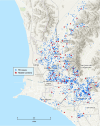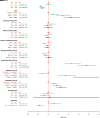Who Transmits Tuberculosis to Whom: A Cross-Sectional Analysis of a Cohort Study in Lima, Peru
- PMID: 38416532
- PMCID: PMC11276835
- DOI: 10.1164/rccm.202307-1217OC
Who Transmits Tuberculosis to Whom: A Cross-Sectional Analysis of a Cohort Study in Lima, Peru
Erratum in
-
Erratum: Who Transmits Tuberculosis to Whom: A Cross-Sectional Analysis of a Cohort Study in Lima, Peru.Am J Respir Crit Care Med. 2024 Nov 15;210(10):1280. doi: 10.1164/rccm.v210erratum8. Am J Respir Crit Care Med. 2024. PMID: 39545752 Free PMC article. No abstract available.
Abstract
Rationale: The persistent burden of tuberculosis (TB) disease emphasizes the need to identify individuals with TB for treatment and those at a high risk of incident TB for prevention. Targeting interventions toward those at high risk of developing and transmitting TB is a public health priority. Objectives: We aimed to identify characteristics of individuals involved in TB transmission in a community setting, which may guide the prioritization of targeted interventions. Methods: We collected clinical and sociodemographic data from a cohort of patients with TB in Lima, Peru. We used whole-genome sequencing data to assess the genetic distance between all possible pairs of patients; we considered pairs to be the result of a direct transmission event if they differed by three or fewer SNPs, and we assumed that the first diagnosed patient in a pair was the transmitter and the second was the recipient. We used logistic regression to examine the association between host factors and the likelihood of direct TB transmission. Measurements and Main Results: Analyzing data from 2,518 index patients with TB, we identified 1,447 direct transmission pairs. Regardless of recipient attributes, individuals less than 34 years old, males, and those with a history of incarceration had a higher likelihood of being transmitters in direct transmission pairs. Direct transmission was more likely when both patients were drinkers or smokers. Conclusions: This study identifies men, young adults, former prisoners, alcohol consumers, and smokers as priority groups for targeted interventions. Innovative strategies are needed to extend TB screening to social groups such as young adults and prisoners with limited access to routine preventive care.
Keywords: interventions; pulmonary tuberculosis; transmission; whole-genome sequencing.
Figures




Comment in
-
One Half of the Pair: Prioritizing Tuberculosis Transmitters for Early Detection.Am J Respir Crit Care Med. 2024 Jul 15;210(2):143-144. doi: 10.1164/rccm.202404-0699ED. Am J Respir Crit Care Med. 2024. PMID: 38687502 Free PMC article. No abstract available.
Similar articles
-
High-resolution mapping of tuberculosis transmission: Whole genome sequencing and phylogenetic modelling of a cohort from Valencia Region, Spain.PLoS Med. 2019 Oct 31;16(10):e1002961. doi: 10.1371/journal.pmed.1002961. eCollection 2019 Oct. PLoS Med. 2019. PMID: 31671150 Free PMC article.
-
Spatial scale of tuberculosis transmission in Lima, Peru.Proc Natl Acad Sci U S A. 2022 Nov 8;119(45):e2207022119. doi: 10.1073/pnas.2207022119. Epub 2022 Nov 2. Proc Natl Acad Sci U S A. 2022. PMID: 36322726 Free PMC article.
-
Protective effects of household-based TB interventions are robust to neighbourhood-level variation in exposure risk in Lima, Peru: a model-based analysis.Int J Epidemiol. 2018 Feb 1;47(1):185-192. doi: 10.1093/ije/dyx171. Int J Epidemiol. 2018. PMID: 29025111
-
Social network analysis and whole genome sequencing in a cohort study to investigate TB transmission in an educational setting.BMC Infect Dis. 2019 Feb 13;19(1):154. doi: 10.1186/s12879-019-3734-8. BMC Infect Dis. 2019. PMID: 30760211 Free PMC article.
-
Vitamin D status and risk of incident tuberculosis disease: A nested case-control study, systematic review, and individual-participant data meta-analysis.PLoS Med. 2019 Sep 11;16(9):e1002907. doi: 10.1371/journal.pmed.1002907. eCollection 2019 Sep. PLoS Med. 2019. PMID: 31509529 Free PMC article.
Cited by
-
Mass incarceration as a driver of the tuberculosis epidemic in Latin America and projected impacts of policy alternatives: A mathematical modeling study.medRxiv [Preprint]. 2024 Jul 22:2024.04.23.24306238. doi: 10.1101/2024.04.23.24306238. medRxiv. 2024. Update in: Lancet Public Health. 2024 Nov;9(11):e841-e851. doi: 10.1016/S2468-2667(24)00192-0. PMID: 39108530 Free PMC article. Updated. Preprint.
-
Erratum: Who Transmits Tuberculosis to Whom: A Cross-Sectional Analysis of a Cohort Study in Lima, Peru.Am J Respir Crit Care Med. 2024 Nov 15;210(10):1280. doi: 10.1164/rccm.v210erratum8. Am J Respir Crit Care Med. 2024. PMID: 39545752 Free PMC article. No abstract available.
-
One Half of the Pair: Prioritizing Tuberculosis Transmitters for Early Detection.Am J Respir Crit Care Med. 2024 Jul 15;210(2):143-144. doi: 10.1164/rccm.202404-0699ED. Am J Respir Crit Care Med. 2024. PMID: 38687502 Free PMC article. No abstract available.
-
Pairs or Paradoxes: Questioning Assumptions in Tuberculosis Transmission Research.Am J Respir Crit Care Med. 2024 Sep 15;210(6):849-850. doi: 10.1164/rccm.202405-0958LE. Am J Respir Crit Care Med. 2024. PMID: 39018563 Free PMC article. No abstract available.
-
Mass incarceration as a driver of the tuberculosis epidemic in Latin America and projected effects of policy alternatives: a mathematical modelling study.Lancet Public Health. 2024 Nov;9(11):e841-e851. doi: 10.1016/S2468-2667(24)00192-0. Epub 2024 Oct 15. Lancet Public Health. 2024. PMID: 39419058 Free PMC article.
References
-
- World Health Organization. https://www.who.int/teams/global-tuberculosis-programme/tb-reports/globa...
-
- Pai M, Kasaeva T, Swaminathan S. Covid-19’s devastating effect on tuberculosis care—a path to recovery. N Engl J Med . 2022;386:1490–1493. - PubMed
-
- Date A, Modi S. TB screening among people living with HIV/AIDS in resource-limited settings. J Acquir Immune Defic Syndr . 2015;68:S270–S273. - PubMed
Publication types
MeSH terms
Grants and funding
LinkOut - more resources
Full Text Sources
Medical

